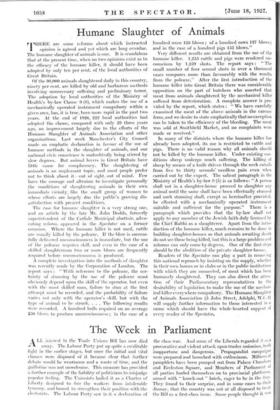- Humane Slaughter of Animals
rrlIERE are some reforms about which instructed opinion is agreed and yet which are long overdue. The humane slaughter of animals is one. It is scandalous that at the present time, when no two opinions exist as to the efficacy of the humane killer, it should have been adopted by only ten per cent. of the local authorities of Great Britain.
Of the 30,000 animals slaughtered daily in this country, ninety per cent. are killed by old and barbarous methods involving unnecessary suffering and preliminary terror, The adoption by local authorities of the Ministry of Health's by-law Clause 9 (b), which makes the use of a mechanically operated instrument compulsory within a given area, has, it is true, been more rapid in the past two years. At the end of 1926, 222 local authorities had adopted the clause, compared with only 59 three years ago, an improvement largely due to the efforts of the Humane Slaughter of Animals Association and other organizations. Last week Manchester's City Council made an emphatic declaration in favour of the use of humane methods in the slaughter of animals, and our national civic conscience is undoubtedly being stirred by slow degrees. But animal lovers in Great Britain have little cause for complacency. The slaughtering of animals is an unpleasant topic, and most people prefer not to think about it--out of sight, out of mind. Few have the courage and altruism to investigate personally the conditions of slaughtering animals in their own immediate vicinity, like the small group of women to whose efforts are largely due the public's growing dis- satisfaction with present conditions.
The ease for humane slaughter is a very strong one, and an article by the late Mr. John Dodds, formerly superintendent of the Carlisle Municipal abattoir, advo- cating reform, appeared in the Spectator on a former occasion. Where the humane killer is not used, cattle arc usually killed by the poleaxe. If the blow is success- fully delivered unconsciousness is immediate, but the use of the poleaxe requires skill, and even in the case of a skilled slaughterman two or more blows are frequently required before unconsciousness is produced.
A complete investigation into the methods of slaughter was recently made by the Corporation of London. The report says : " With reference to the poleaxe, the cer- tainty of stunning by the use of the poleaxe must obviously depend upon the skill of the operator, but even with the most skilled man, failure to stun at the first attempt must be recorded, and the probability of failure varies not only with the operator's skill, but with the type of animal to be struck. . . . The following results were recorded. A hundred bulls required on an average 250 bloWs to produce unconsciousness ; in the case of a hundred oxen 123 blows ; of a hundred cows 127 blows ; and in the case of a hundred pigs 155 blows."
Very different results are obtained from the use of the humane killer. 1,255 cattle and pigs were rendered un- conscious by 1,259 shots. The report says : " The small number of four second . shots in over a thousand cases compares more than favourably with the results from the poleaxes" After . the first introduction of the humane killer into Great Britain there was considerable opposition on the part of butchers who asserted that meat from animals slaughtered by the mechanical killer suffered from deterioration. A complete answer is pro- vided by the report, which states : " We have carefully examined the meat of the above animals in the carcase form, and we desire to state emphatically thatno exception can be taken to the efficiency of the bleeding. The meat was sold at Smithfield Market, and no complaints were made or received." .
In many of the districts where the humane killer has already been adopted, its use is restricted to cattle and pigs. There is no valid reason why all animals should not be killed by the humane killer. Under existing con- ditions sheep undergo much suffering. The killing of sheep by means of a knife driven through the neck entails from five to thirty seconds' needless pain even when carried out by the expert. The salient paragraph in the Ministry of Health's by-law 9 (b) is as follows: "A person shall not in a slaughter-house proceed to slaughter any animal until the same shall have been effectually stunned and such stunning shall, except as hereinafter provided, be effected with a mechanically operated instrument suitable and sufficient for the purpose." There is a paragraph which provides that tbe by-law shall not apply to any member of the Jewish faith duly licensed by the Chief Rabbi as a slaughterer. Apart from the intro- duction of the *mane killer, much remains to be done in building slaughter-houses so that animals awaiting death do not see those being killed, birt this is a large problem and reforms can only come by degrees. One of the first steps should be the abolition of the private slaughter-house.
Readers of the Spectator can play a part in removing this national reproach by insisting on the supply, whether in their own homes or in clubs or in the public institutions with which they arc connected, of meat which. has been humanely slaughtered. They can also direct the atten- tion of their Parliamentary representatiVes to the desirability of legislation to make the use of the mechan- ical killer everywhere compulsory. The Humane Slaughter of Animals AssoCiation (5 John Street, Adelphi, W.C. 2) will supply further information to those interested in cause which should have the' whole-hearted support of every render of the Spectator.


























































 Previous page
Previous page